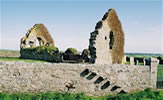St Mary's Chapel Rattray
 This ancient site has associations with people and families who have influenced the course of history in Scotland and beyond.
This ancient site has associations with people and families who have influenced the course of history in Scotland and beyond.
The Chapel, which was constructed in the 13th century, is one of the oldest structures still standing in North East Scotland. The use of this site for religious purposes almost certainly predates the Chapel through an association with the spread of Christianity in Buchan during the 6th to 8th centuries.
The structure is thought to have been erected by William Comyn as a private chapel, dedicated to a son who was drowned accidentally in a well.
The first recorded reference to the site is in 1220 through note of a gift made by William Comyn, Earl of Buchan. This gift was initially in the form of alms and later in money. Further mention is made in 1451 and 1460. In 1460 King James III confirmed a charter for the payment of five pounds (Scots) and two stones of wax to the chapel of the ‘Beate Marie Virginis of Ratreff’, (Blessed Virgin Mary of Rattray). This annual payment was probably continued until the Reformation in 1560.
 The plain architectural form and general finishes of the chapel would have been in sharp contrast to the workmanship on the decorative detailing of the window and doorway openings. Although the chapel may have served the Burgh of Rattray until the great storm of 1720, which sealed the fate of the settlement, it is more likely it was simply replaced by the Parish Kirk of Crimond about 1576 following the Reformation. The old Parish Kirk was itself replaced in 1812 by the present kirk in the village of Crimond. The new kirk is associated with the loveliest of hymn tunes ‘Crimond’, and has a clock which has 61 minutes on its face. A granite stone, dated 911AD, built into the south wall in the 19th century does not relate to any known event associated with the chapel.
The plain architectural form and general finishes of the chapel would have been in sharp contrast to the workmanship on the decorative detailing of the window and doorway openings. Although the chapel may have served the Burgh of Rattray until the great storm of 1720, which sealed the fate of the settlement, it is more likely it was simply replaced by the Parish Kirk of Crimond about 1576 following the Reformation. The old Parish Kirk was itself replaced in 1812 by the present kirk in the village of Crimond. The new kirk is associated with the loveliest of hymn tunes ‘Crimond’, and has a clock which has 61 minutes on its face. A granite stone, dated 911AD, built into the south wall in the 19th century does not relate to any known event associated with the chapel.
As a result of neglect over many years, the kirkyard with its broken down walls had almost become part of the surrounding farmland. In 1848 through monies provided by a former parishioner, the present walls were constructed.
Rattray ... a vanished Royal Burgh
The site of the original village of Rattray was centred on the site of the now-vanished Castle of Rattray, an inconspicuous mound beyond the farm of Old Rattray, just beyond this chapel. In 1564, the community here was granted Royal Burgh status by Mary, Queen of Scots. This entitled it to a mercat (market) cross, a weekly market, two fairs a year, as well as the right to dispense justice locally through its court. It also gained foreign trading rights. However, these advantages were granted not because it was thriving, but in order to settle a dispute between the Hays, Earls of Errol, and the Keiths, Earls Marischal, two neighbouring landowners who disagreed over ownership of the village. By making it a Royal Burgh, the Crown benefited from the taxes and levies raised locally – and, more importantly, Queen Mary damped down a quarrel between two powerful families.
Rattray at that time had a safe landing place. It overlooked the Loch of Strathbeg, which was much smaller than it is today, and had a sea connection from this end of the loch. The local boats used this sheltered haven and the village achieved some fame for the quality of its codfish. However, shifting sands over the years proved treacherous. These sands gradually accumulated around the harbour area, making the channel increasingly difficult. As a result, Rattray did not prosper. The villagers never built houses in stone, as they were urged to do.
The community received its final setback in 1720 when a great gale moved a sand dune and blocked the loch’s sea exit. Tradition tells of the trapping within the loch of a vessel with a cargo of slates. Some folk continued to fish, drawing their boats onto the open shore at Rattray head, but without its harbour, the village was doomed and soon dwindled away.
The remains of St Mary's Chapel were consolidated as part of Aberdeenshire's Historic Kirkyards project in 2006.
Further information can be found in the leaflet St Mary's Chapel, Rattray (PDF 349KB) produced by Aberdeenshire Council.
Information regarding the survey undertaken in 1998 on St Mary's Chapel can also be downloaded.
